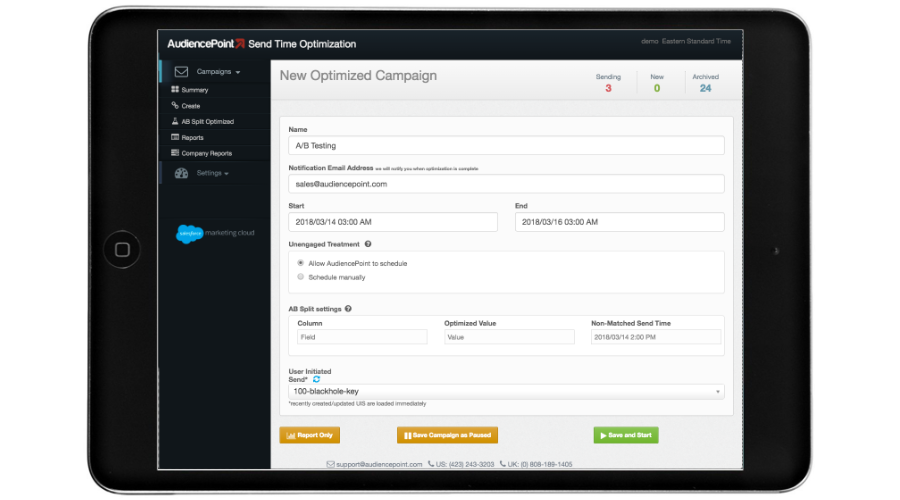AudiencePoint is thrilled to announce our new integration with Klaviyo! AudiencePoint is looking for partners to pilot our...
Do you need help with low inbox placement rates and wondering why and how you can improve it? You’re not alone. Many email marketers can end up with inbox placement issues.
Whether it’s using ineffective email marketing strategies, sending the wrong types of content to your audience, or building an unverified email list, there are many factors that affect where your campaign emails land once they’re delivered.
Whatever the cause, there are many suggestions that can help. This article will provide a complete guide on how to improve inbox placement, what email address verification tool you should use, and resources that can help in the process. Keep reading to learn more.
What Is Inbox Placement?
Inbox placement rate is a measurement of how many of your delivered emails land in subscribers’ primary inboxes. It’s an important metric when you’re trying to determine how much of your content lands in spam folders.
Landing in spam folders not only impacts your engagement on a single email marketing message but can also have lasting effects on sender’s reputation that causes an increasing amount of your content to go to spam when it isn’t addressed.
What Is the Difference Between Inbox Placement and Deliverability?
If you’re familiar with the term deliverability, you may wonder how placement differs since they both have to do with the successful delivery of marketing emails. The main thing you need to keep in mind is that placement is a sub-category of deliverability, so its purpose is to provide you with more information about the emails that are delivered.
Inbox placement rate measures how many of your delivered emails land in the inbox. That differs from deliverability, which measures the number of emails delivered out of all the emails you’ve sent. Under the deliverability metric, an email that lands in a spam folder would still count as “delivered.”
That said, that doesn’t mean the deliverability metric is useless. It still does a great job providing information about how many emails you send bounce. It’s just helpful also to have a placement rate to help you prevent your content from being marked as spam.
What Affects Inbox Placement?
Now that you know the importance of placement, you’re probably still wondering what can cause poor inbox placement rates to occur. Here are some of the main reasons.
1. An Unverified Email List and High Bounce Rates
When you have poor deliverability due to an email list, use an email address verification tool to filter fake email addresses that may send many bad signals to inbox providers.
If your emails are constantly bouncing, suddenly, providers will start marking more and more of your content that is delivered as spam, even for users who don’t submit spam complaints. These effects can get out of hand quickly.
2. Consistently Low Engagement
An unengaged audience can cause similar issues to the unverified one. When subscribers consistently ignore your emails or instantly delete them, it sends bad behavior signals to inbox providers.
Again, this leads to more content automatically going to spam folders, or it may start going to less than advantageous sub-folders like promotions that most consumers don’t check very much.
3. Lots of Spam Complaints
If consumers actively report your content as spam because they didn’t know they signed up for your list, can’t figure out how to unsubscribe, or simply don’t like your content, it’s a major red flag for inbox providers.
When this gets out of hand, your content will go to spam for those who mark it as such and may also start automatically going to spam for other subscribers who never reported it.
How Do I Check My Inbox Placement?
Seeing all the effects that inbox placement can have, you’re probably wondering if there’s an inbox placement rate calculator or tools that can determine if you have an issue.
Several inbox placement tools can help you predict how likely your content will be delivered to primary inboxes or consistently track the placement rates from your campaigns.
If you’re looking for assistance, our tools at AudiencePoint can help track metrics to ensure your emails are landing in inboxes and give you actionable insights that will help you improve your placement rates. Rather than relying on seed lists our inbox placement solution will use subscriber engagement data to measure your real inbox placement. Let’s break down exactly how our other tools will help you improve your inbox placement.
How Can I Improve My Inbox Placement?
Here are the top three ways you can improve inbox placement rates.
1. Send the Right Types of Content
In email marketing, the most important thing is to ensure you’re always offering value to subscribers and sending them the information they care about the most. Our tools at AudiencePoint will help you analyze campaign data in real-time so you always know how your subscribers engage and what they engage with most to plan future content effectively.
2. Send Content at the Right Time
The time you send content matters since subscribers will be more likely to engage at different times of the day.
So if you’re looking to boost engagement to improve placement, you can use our Send Time Optimization tool at AudiencePoint to identify the exact times when subscribers usually check inboxes and time your emails to send right before to give yourself the best chance of standing out.
3. Clean Up Your Email List
If you have high bounce rates and many unengaged subscribers, it’s time to clean up your list so you can improve deliverability and placement. AudiencePoint can help with our tool ListFit which tracks subscriber activity to help verify subscribers are active, identify re-engagement opportunities, and help you suppress dormant emails.
How AudiencePoint Can Help
As you can see, AudiencePoint can help you improve inbox placement in many ways. Plus, our tools are not only meant to improve placement and deliverability but also help you maintain great results over the long term.
When you use AudiencePoint, you get more than just metrics about your content’s performance. You actually get insights that are easy to implement and will help you improve the success of your campaigns. That includes improving placement, boosting engagement, increasing conversions, and much more.
If AudiencePoint sounds like it may be the solution for your needs, contact us today to learn more about getting started.





